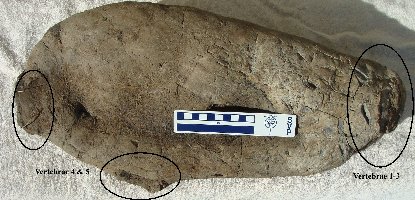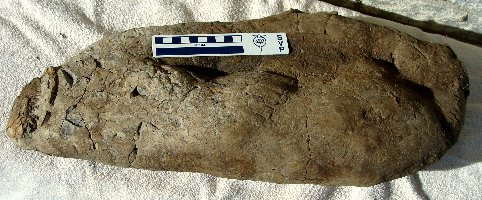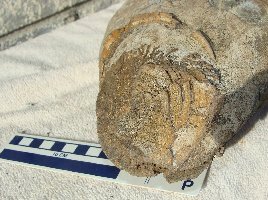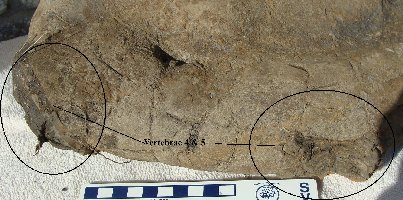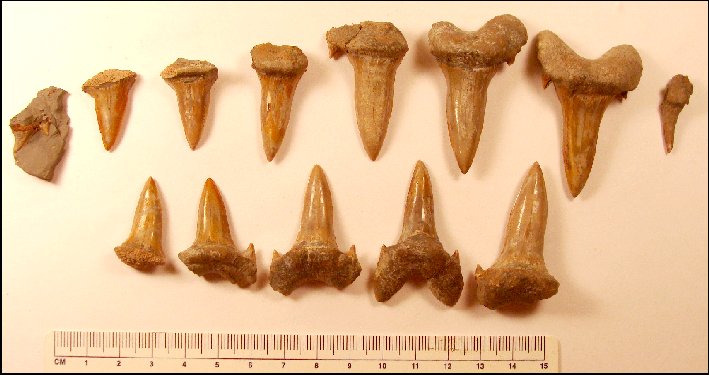 |
Cretodus crassidens
Shark remains (FHSM VP-17575) from the Blue Hill Shale
of Mitchell County, Kansas
Copyright © 2010-1013 by Mike Everhart
Adjunct Curator of Paleontology,
Sternberg Museum of Natural History
Created 06/09/2010;
Last updated 10/07/2013
LEFT: Teeth of the Cretodus
crassidens (FHSM VP-17575) specimen in
lingual view, collected in 2010 from the Blue Hill Shale of southwestern
Mitchell County, Kansas.
|
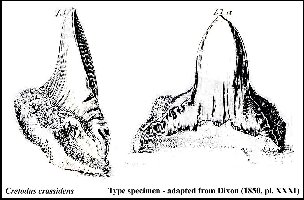 |
Cretodus crassidens is a large (extinct) lamniform
shark with a worldwide distribution during Cenomanian-Turonian time (Late
Cretaceous). Until now, it was only known
in North America from isolated (shed) teeth (Shimada, 2006). The
species was originally named Oxyrhina crassidens by Frederick Dixon (1850) on
the basis of a single tooth found in the county of West Sussex in southern
England. The genus name was changed to Cretodus
by M. Sokolov in 1965.
The
original description by Frederick Dixon
,
1850, p 367:
Genus
Oxyrhina, Agassiz.
Oxyrhina crassidens, new, R. 3. (Tab. XXXI. figs. 13 &
13".) This
large and thick tooth I discovered at Houghton; it differs from O.
Mantelli by
being shorter and more obtuse. The shoulders are deeply corrugated,
almost to give the appearance
of the lateral denticles of an Otodus.
|
In March, 2010, I returned to the site where I had
collected fragments of a large plesiosaur rib (Everhart, 2010) from the Blue
Hill Shale in southwestern Mitchell County, Kansas. Accompanying me were Gail
Pearson (who in 2008 discovered the only known
skull of the turtle Desmatochelys lowii from Kansas) and Fred Smith,
editor of the local newspaper. While Gail and I were collecting additional rib
fragments, Fred went further upslope to the east and found what he thought was a
piece of petrified wood in a concretion. We went over to see what he had
discovered and I immediately recognized the circular objects with the concentric
growth rings as shark vertebrae....A really, REALLY nice discovery for
Fred's first
time collecting in the Blue Hill Shale. Based on their large size, I
suspected that they were from a large lamniform shark called Cretodus, but
without a tooth to confirm the identification, there was no way to be certain. The shale was too wet
that day to do any exploratory digging for other remains,
so we decided to mark the site and wait for drier weather. As often happens in
Kansas winters, a blizzard swept through north central Kansas the next day
and we had to wait until
April. (CLICK ON THE PICTURES TO ENLARGE)
The return trip in April was rained out when an overnight
thunderstorm dumped several inches of rain on Mitchell County and made the trail
into the site impassible. Due other other commitments, I had to postpone the
next opportunity until early June. We were very fortunate to get a break
in the warmer weather and have cool, cloudy day. Loading up in our 6-wheeler all
terrain vehicle, we drove up to the site and found that things looked a bit
different from when we were there three months earlier. Several big rains and
the verdant growth of the prairie had markedly changed the appearance of the
area. However, we quickly found our marker and started digging....
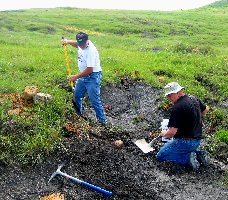 |
LEFT: Here Gail (left) and I are removing shale from
around a small concretion. As it turned out, we wasted about
an hour digging at this spot and found nothing. It was cloudy and cool at
this point, but the sun was starting break though. (Photo by Fred Smith)
As we were getting ready to assume the worst
and walk away, Fred went up the hill and found another stone marker. Once
we saw it, Gail and I
confirmed that it was in fact the marker he had left on the site last
March. At that point, we realized our mistake and started to remove the
shale at the new spot. Afterwards, I realized that the first marker was one
that I had left there in 2008 on the site where I had collected the
plesiosaur rib fragments.
|
It didn't take very long to discover new shark remains,
right where we had hoped to find them... (CLICK ON THE PICTURES TO
ENLARGE)
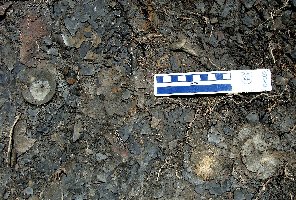 |
LEFT: First we discovered several vertebral centra that
were preserved outside of a concretion. I suspect that they were scattered
far enough apart prior to being fossilized that concretions could not form
around them. That said, they were invaded by roots and badly fractured by
the slumping shale as it weathered.
RIGHT: Here Gail is removing some of the shale over the shark
remains as we explored the area around concretions.
|
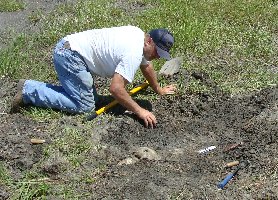 |
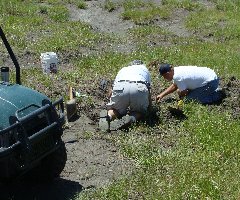 |
LEFT: Because we are concentrating on what is in the
ground, it is nearly impossible to get a good picture of a person's face
while they are working on a dig.... but relatively easy to get photos of
the other end.
RIGHT: Soon after we discovered the centra, I found the first shark
tooth. Definitely an anterior from a large Cretodus. Now we knew
for certain what we were collecting. |
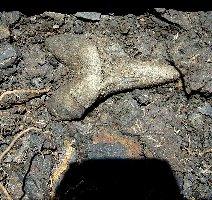 |
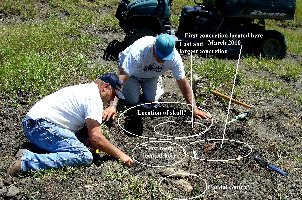 |
LEFT: Here's a general view of the dig site, with Gail
Pearson on the left and Fred Smith in the middle. The outlines show the
general location of the remains that we collected on June 6 and also the
concretion that Fred discovered on March 18. The little Polaris
six-wheeler in the background is a lifesaver!
RIGHT: Another view of the site with Gail and Fred down in the
classic "paleo-position" working on the shark. In the
background, you can see a good view of the "Blue Hills" of
Kansas. |
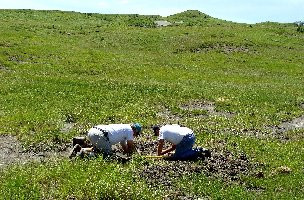 |
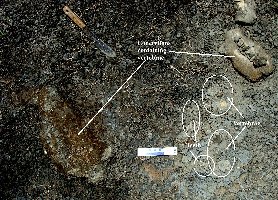 |
LEFT: An overhead view the area we were working with
notations for the locations of the concretions, shark centra and teeth
that were collected. Note that the "neck" on left side of
the largest concretion is an articulated series of centra that head off
into the undisturbed shale. We are hopeful that the head of the shark, or
at least a large number of teeth will be found there.
RIGHT: A closer view of the largest concretion that we collected. |
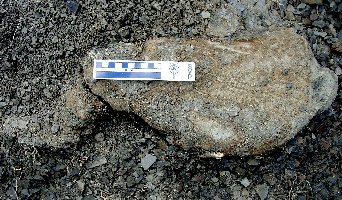 |
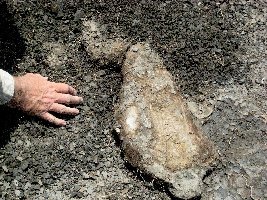 |
LEFT: Another view of the largest concretion with my hand
included for scale. The last tooth we found on June 6 was located roughly
under my hand, along with another large vertebral centra. (Photo by Fred
Smith)
RIGHT: When found, the shark teeth were about the same color as the
rest of the shale, and were usually visible only by their shape.
(Photo by Fred Smith) |
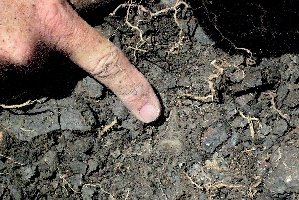 |
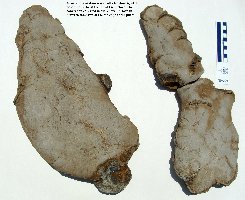 |
LEFT: The three phosphatic concretions that we collected
on June 6. The two on the right contain the smallest centra that we
found, and suggest that they were part of the tail or at least the rear
part of the shark.
RIGHT: The smallest concretion that we collected with at least 9
visible centra. This one was located adjacent to the second largest
concretion, but not solidly connected to it. It was actually partially
exposed on the surface when we found it, hidden in the grass near my knee. |
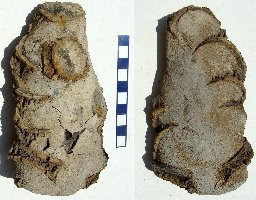 |
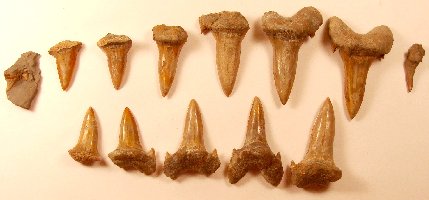 |
LEFT: These are the Cretodus teeth in lingual view
that we collected on June 6. Once cleaned with water and a soft brush,
they look pretty impressive! The arrangement is completely artificial,
based only on decreasing size toward the back of the shark's mouth, but
the fact that several of the smaller teeth are leaning different
directions suggests that we have teeth from opposing jaws (upper / lower
or right / left). A complete upper and lower
jaw set would look something like this for Cretoxyrhina mantelli.
RIGHT: A close-up of one of the larger anterior teeth from this
specimen. This shark would have been comparable in size and feeding
behavior to a modern Great white, or to a Cretoxyrhina mantelli from
the Smoky Hill Chalk. |
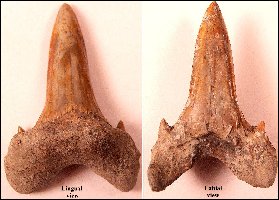 |
Shimada (2006) noted that "The
teeth of Cretodus crassidens are large
and robust. … Each tooth possesses a central cusp with a pair of triangular
lateral cusplets, and a bilobed root. The central cusp shows many minute,
wrinkle-like striations along the base. Lateral cusplets have a broad base and a
triangular shape, but are much smaller than the central cusp. The root is
massive and the basal concavity varies from narrow to broad, presumably
depending on tooth positions. Cretodus
crassidens is known only by its teeth, which are common
in Turonian marine deposits of
North America
(e.g., Cappetta, 1987; Stewart and Martin, 1993; Welton and Farish, 1993;
Cappetta and Case, 1999; Cicimurri, 2004). Schwimmer et al. (2002) recently
suggested that C. crassidens is
conspecific with C. semiplicatus (Münster
in
Agassiz
, Cappetta and Case (1999), and Cicimurri (2004), who separated C.
crassidens from C.
semiplicatus.
Dig Number 2 - June 22-23,
2010
Kenshu Shimada joined us on
June 22-23 to continue the excavation of the shark remains. We recovered about
80 more teeth as we enlarged the pit area to the east and north. We kept
remarking that we hadn't found any more vertebrae (most were collected in the
concretions during the first dig), but late in the afternoon I ran into a large
vertebra that was basically in line and north of where the others had
occurred. A second and a third followed quickly... and then three more on
Day 2 when we enlarged the pit again. It appears that the shark remains have
been sorted somewhat by currents / tidal action before final burial.. With
the last last three vertebrae that I removed on Thursday,
we are still looking for the north and west 'edges" of the dig....
and of course are going upslope and deeper into the hill. The south edge
is downslope and the east edge apparently ends in a shallow gully. The good
thing is that as we further below the layer of top soil, we should encounter
fewer roots (and root damage).
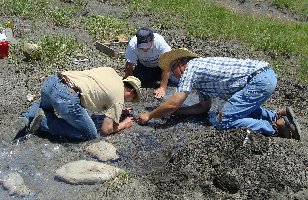 |
LEFT: On Day 1 of the second dig, Kenshu Shimada and I
started off by mapping the location of the previously collected specimens
(concretions containing vertebrae, other vertebrae and teeth at lower left
) on a large shell of clear vinyl. Here Kenshu, Gail and Fred map some of
the many teeth that we discovered as we enlarged the pit. We suspended
digging periodically to map in the teeth that we found so we could remove
them for safe storage.
RIGHT: A closer view of the vinyl sheet showing the outlines of the
concretions, vertebrae and teeth. I wish I could show a picture of all the
teeth we collected (90+)... but that will have to wait until we get them
cleaned up. |
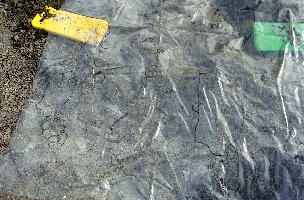 |
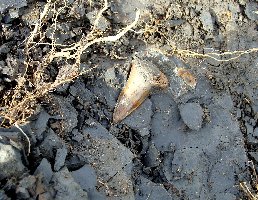 |
LEFT: A very nice crown of a big anterior replacement
tooth... the outline of the incomplete root and accessory cusplets can be
seen as a thin film on the shale. The roots are from some of the
native grasses (mostly Big Bluestem - Andropogon gerardii) that
make up much of the original stand of prairie on this ranch. This land has
been grazed by cattle (and buffalo for thousands of years before them)...
but never broken to the plow.
RIGHT: This tooth was badly weathered and fractured by the time Gail
discovered it. We had to give it a coating of PaleoBond just to be able to
get it out of the shale. |
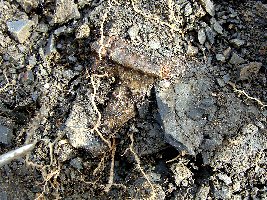 |
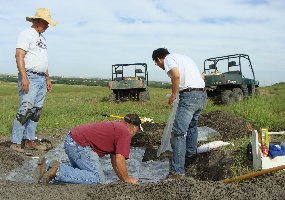 |
LEFT: More mapping on Day 2 of the second dig.
RIGHT: The dig crew, left to right: Fred Smith, Gail Pearson, Kenshu
Shimada and Mike Everhart. Note that the roll of Duct Tape in the
foreground of the picture was used to patch the plastic sheets together...
not the fossils!
It's a busy time of the year, so we temporarily closed the dig for
another day. Kenshu is heading back to Chicago and I have to run a
field trip out of the Sternberg Museum... Fred and Gail are in the middle
of the 2010 wheat harvest. We had a great two days with near perfect
weather for June in Kansas. More to come. |
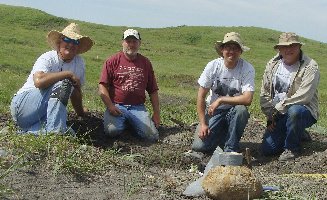 |
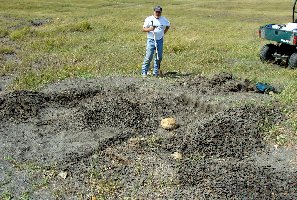 |
Gail and I returned to the site in late August, 2010, to
continue the dig in the area where I had found the last vertebra in
April.
LEFT: Gail Person standing behind our new excavation. The concretion
marks the area where the last shark vertebra was located. We dug about two
feet to the west and north but did not encounter any additional remains.
RIGHT: Another view of the final dig, facing northeast. |
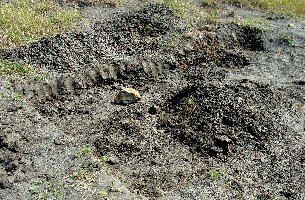 |
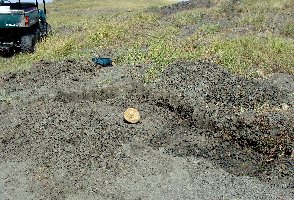 |
LEFT: ...and a third view facing west.
RIGHT: Although we did not find any additional remains in the new
excavation, we did recover these fragmentary teeth from the spoil
piles.
Postscript: A follow-up visit in the spring of 2011 by Kenshu
Shimada and I recovered a few more teeth and teeth fragments. At this
point, it appears that we have recovered all of the remains that were
present at the time of discovery. |
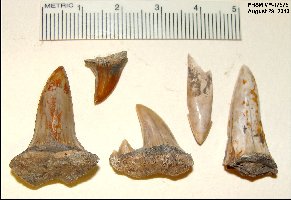 |
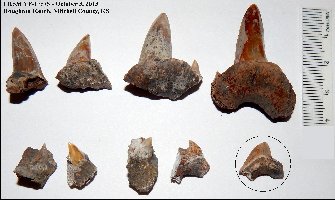 |
Fast forward to October 3, 2013 and another visit to the
shark site. Contrary to the statement above, and in spite of our
efforts, it appears that some teeth managed to hide from being
collected... I'll have to check it again in the spring.
LEFT: Four fairly complete Cretodus teeth and four fragments
containing cusplets. The tooth in the circle is Squalicorax falcatus,
possible from a much smaller shark that was scavenging the Cretodus carcass.
Large tooth at upper right is shown RIGHT.
RIGHT: A very nice tooth from the anterior portion of the jaw. This
tooth was located insitu at the very front of the dig (see
white marker, south side) and was probably missed in the initial work
on the site. This part of Mitchell County has received a lot of rain in
the last year or so and the vegetation is recovering nicely from the
earlier drought. |
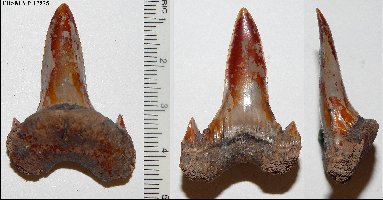 |
|
Poster
presentation at the 71st Annual Meeting of the Society of Vertebrate
Paleontology - Las Vegas, NV - 2011
FIRST
ASSOCIATED SPECIMEN OF THE LATE CRETACEOUS SHARK, CRETODUS (ELASMOBRANCHII:
LAMNIFORMES)
SHIMADA,
Kenshu, DePaul University, Chicago, IL, USA; EVERHART, Michael, Sternberg
Museum of Natural History, Hays, KS, USA; REILLY, Brian, Children’s
Memorial Hospital, Chicago, IL, USA; RIGSBY, Cynthia, Children’s
Memorial Hospital, Chicago, IL, USA
Approximately 120 teeth and 60 vertebrae of a large lamniform shark, Cretodus
crassidens (
Dixon
), were recently collected from the Blue Hill Shale Member (Middle
Turonian) of the Carlile Shale near Tipton in Mitchell County, Kansas,
USA. The specimen, now housed in the Sternberg Museum of Natural History,
Hays,
Kansas
(FHSM VP-17575), is significant because it represents the first known
reasonably complete, associated material of the genus Cretodus Sokolov.
The tooth set includes both functional and replacement teeth in which the
tallest fully developed tooth is about 41 mm in crown height and 52.5 mm
in total tooth height. Although a strong tendency of monognathic
heterodonty is exhibited, the inferred dental pattern is of the lamnoid
type with at least 10 tooth rows in each jaw quadrant. Because many teeth
have a tall erect main cusp with at least one pair of lateral cusplets,
the dentition was suitable for grasping prey. Unlike the teeth, many
vertebrae occurred in articulation within irregularly-shaped concretions
from which a total vertebral count was taken based on radiographic
examination using a computed tomography scanner. The vertebrae are also of
the lamnoid type, and they measure up to 74 mm in diameter. If one
compares the largest centrum diameter and the largest crown height in the Cretodus
specimen to those of another Cretaceous lamniform, Cretoxyrhina
mantelli (
Agassiz
), this Cretodus specimen is extrapolated to have measured between
4.2 and 5.1 m in total length. Because large individuals of Cretoxyrhina
mantelli have previously been interpreted to be formidable predators,
it is likely that large Cretodus individuals also occupied the
highest trophic level within their preferred range. Whereas Cretodus
crassidens and Cretoxyrhina mantelli lived contemporaneously,
based on the fossil record the two taxa likely practiced resource
partitioning within the North American Western Interior because the former
occurs more commonly in nearshore deposits and the latter in off-shore
deposits. |
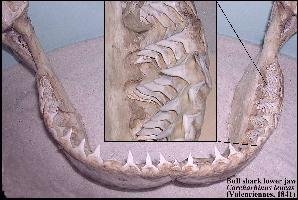 |
REPLACEMENT TEETH IN SHARKS - For those of you not familiar
with how teeth are formed in sharks, here's a short
explanation....
LEFT: The lower jaw of a modern Bull Shark (Carcharinus
leucas) on exhibit in the Fryxell Geology Museum at Augustana
College, Rock Island, IL. This jaw is about 30 cm (12 in.) across and
nicely illustrates the process by which shark teeth are formed in rows or
'families' of 7 or more teeth on the insides of the lower and upper jaws.
The crown of the tooth is formed first, with the root to be added as the
crown moves along the "assembly line" toward edge of the jaw. As
the tooth matures, it rotates almost 180 degrees and moves over the edge
of the jaw, replacing an older tooth which has been shed. The picture also
illustrates the differences in size and shape of the teeth from front to
back in the same jaw (note that the shape of the teeth, especially the
shape of root, can also differ between the upper and lower jaws).
Teeth are replaced at intervals from a few weeks to several months,
depending on the age of the individual shark and the species. A single
shark may shed thousands of teeth during its lifetime. |
Suggested references:
Cappetta, H. and Case, G.R. 1987. Chondrichthyes II - Mesozoic and
Cenozoic Elasmobranchii. Gustav Fischer Verlag, Stuttgart and New York. 193 p.,
148 fig.
Cappetta, H. and Case, G.R. 1999. Additions aux faunes de sélaciens
du Crétacé
du Texas (Albien superier-Campanian). Paleo Ichthyologica 9:5-111, 8 fig. 1
table, 30 pls.
Cicimurri, D.J. 2004. Late Cretaceous chondrichthyans
from the Carlile Shale (Middle Turonian to Early Coniacian) of the Black Hills
region, South Dakota and Wyoming. The Mountain Geologist 41(1):1-16.
Dixon, F. 1850. Geology and fossils of the Tertiary and
Cretaceous formations of Sussex. pp. i-xvi; 1-422.
Everhart, M.J. 2009. Probable plesiosaur remains from the Blue
Hill Shale (Carlile Formation; Middle Turonian) of north central
Kansas. Kansas
Academy
of Science, Transactions 112(3/4):215-221.
Everhart,
M.J., Everhart, P., Manning, E.M. and Hattin, D.E. 2003. A Middle Turonian
marine fish fauna from the Upper Blue Hill Shale Member, Carlile Shale, of north
central Kansas. Journal of Vertebrate Paleontology, Volume 23 (Supplement to
Number 3): 49A.(Abstract)
Schwimmer,
D.R., Hooks, G.E., III and Johnson, B. 2002. Revised taxonomy,
age, and geographic range of
the large lamniform shark Cretodus semiplicatus.
Journal of Vertebrate
Paleontology 22:704–707.
Shimada, K. 2006. Marine
vertebrates from the Blue Hill Shale Member of the Carlile Shale (Upper
Cretaceous: Middle Turonian) in Kansas. In Lucas, S.G. and Sullivan, R.M.
(eds.), Late Cretaceous vertebrates from the Western Interior. New
Mexico Museum of Natural History and Science Bulletin 35, p. 165-175.
Shimada, K., Everhart, M.J., Reilly, B. and Rigsby, C. 2011.
First associated specimens of the Late Cretaceous shark, Cretodus
(Elasmobranchii: Lamniformes). Society of Vertebrate Paleontology, Abstracts of
the 71st Meeting (Las Vegas), p. 194.
Sokolov, M. 1965. Teeth evolution of some genera of Cretaceous sharks
and reconstruction of their dentition. Moskovkoe Obshchestvo Ispytatelie Prirody,
Biulleten Otodel Geologicheskii
40:133-134.
Stewart, J.D. and Martin, J.E. 1993. Late Cretaceous
selachians and associated marine vertebrates from the Dakota Rose Quarry, Grant
County, South Dakota. Proceedings of the South Dakota Academy of Science 72:241-248.
Welton, B.J. and Farish, R.F. 1993. The collectors
guide to fossil sharks and rays from the Cretaceous of Texas. Horton Printing
Company, Dallas, 204 pp.



